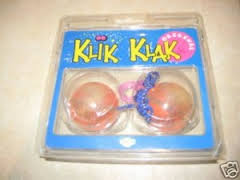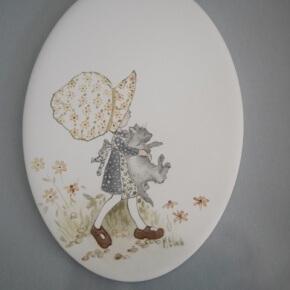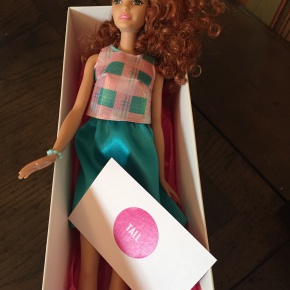Were you into Barbie when you were little?
I was never particularly interested in her; instead my toys of choice were a pair of “Klik Klaks ” and a Holly Hobbie Doll. They went with me everywhere until one day I lost the Klik Klaks by letting go of them and inadvertently hurling them to the top of a large willow tree. There they hung, taunting me for years, refusing to fall down and just a wee bit too high up for me to reach.
Holly was very special. To me she was real and I imagined her to be like another sister. We set off on many backyard adventures together. When I was around 7, my mother further brought her to life by painting a sweet picture in which my Holly is dragging a black cat around; much like I did with my own cat. It is something that I cherish and it now hangs proudly in my daughter’s room. My mother never bought me a Barbie doll and I did not miss it at all. It wasn’t because I disliked them, just that I didn’t relate to them. But then again, I had a girlfriend who says she loved her Barbie so much that she used to sleep with her and wake up with plastic stab marks in her face from the doll’s pointy little hands. She had the town house, the camper van, Ken ~ the works.
When my own daughter was young I bought her a Barbie doll. She hadn’t asked for one, but all her mates seemed smitten, so I assumed that she would like to play with one as well. Nup, poor Barbie sat stuffed at the bottom of a toy box whilst my daughter dragged around her stuffed Koala, a small plastic tea set and a pet rock. In fact my son enjoyed playing with Barbie more than my daughter ever did and I just loved that he did.
When I was growing up in the late 60s and throughout the 70s, societal gender-stereotyping was in full swing. Young girls were supposed to play and keep house and boys were supposed to shoot ’em up. Girls were dressed in pink and boys in blue. It was all so very dull and repressive. Much of this remains today. If it’s the child’s choice and what presses their buttons ~ that’s great. But my heart twists for kids of that generation who were labelled as odd simply because they seemingly wouldn’t or couldn’t ‘conform’. Parents were actively discouraged from allowing their children to deviate from what was considered socially acceptable. For example, my favourite colour was green which I was freely allowed to wear at home, in fact I could wear anything I wanted to, but I was always thrust into a “pretty” floral dress, scratchy tights and a pair Mary Jane shoes whenever we went out.
However, the feminists of the 60s and 70s agitated somewhat successfully for gender equality and freedom of choice in all things, so thankfully many views had changed significantly by the time my children were born in the early 2000s (there is still much to be done). All of a sudden Lego started making pink and pastel coloured bricks and sweet little female scientists and doctors (Still an echo of the stereotyping of pink for girls, but I guess a step in the right direction). Disney was, for the first time making Princesses the Hero (think Maleficent and Frozen and the latest Star Wars movie). She no longer needed to rely on a Prince to rescue her from a sticky situation. Advertisers such as Dove and Always were pushing campaigns which championed strength, independence and individuality, rather than appearance, as a girl’s new currency. Always is to be applauded for their latest offering about the stereotypical use of emojis. You can watch it here. Great stuff. And of most interest to me, many girl’s high schools have begun actively pursuing excellence in Science, Technology, Engineering and Maths.
But back to Barbie. Ruth Handler and Bild Lilli have a lot to answer for (in fairness, Ruth was of her time). Since 1959 Barbie has stayed the same. That’s 57 years of being forced to forever walk on tiptoes even if they’re not wearing ridiculously high stilettos. Her figure was modelled on a totally unrealistic and unattainable female shape and size. Indeed if she were a real person, she would collapse, unable to hold herself up due to the size of her breasts and the lack of a waist. Her back would break or she’d suffocate due to the pressure placed on the rest of her tiny body.
I’d argue that few little girls truly believed they could be like Barbie but that’s not the point. What always irritated me was that society wanted girls (or advertisers told us) to aspire to be like her. I’m sure confident, self-assured girls would shake it off, laugh and play with a doll to whom they couldn’t personally relate but could have great fun with nonetheless. On the other hand, an emotionally insecure girl may well have grown up believing she’d never be good enough in the eyes of her male counterpart or society in general.
Many, many brands and retailers still have a long way to go. For example, my teenage daughter adores Victoria’s Secret. But it worries me that this iconic brand still persists with advertising that showcases unattainable female images. As my friend says, Victoria’s Secret models are simply real life Barbies with wings…
And so this brings me to the newly-released range of Barbie dolls. Like other informed retailers, Mattel has finally realised that girls want, no are demanding, a product that more accurately reflects who they truly are. So we now have curvy, tall and petite Barbies. They sport a range of different coloured hair and clothes and looks. They still walk on tiptoes but adding a suite of more realistic Barbies is a giant leap forward and Mattel are to be congratulated. Let’s give them a quiet round of applause please. If however, they choose to do the same with Ken, I’ll give them a standing ovation. Imagine the poor boys who grow up believing they have to look like Ken or worse, aspire to his wardrobe.
I understand that there needs to be a balance between aspiration and inspiration when it comes to product development and retailing. However, if Mattel keep working towards more realistic dolls, I’d love to see them develop a gender neutral Barbie. A doll who, like the current generation doesn’t define themselves by gender at all. As Michelle Newton, Director of Cultural Forecasting at Galkal Australia says, “The current generation are driving cultural change to the point where males and females will be judged by their values and attitudes as an individual first and foremost above and beyond their sex. This applies to all environments from schools to the workplace. It is different to feminism as a construct. It surpasses this fight in a sense, as it is about neutralising the argument. A recent JWT Intelligence research report found that 82% of Generation Z say they don’t care about sexual orientation at all.” So, maybe the kids of the current generation will stop caring so much about appearance and instead celebrate and value people for their attitudes, individuality and beliefs. And if retailers such as Mattel keep following suit, I’ll buy Barbies until the cows come home.
Until next time…
This is not a sponsored post.



Leave a Reply